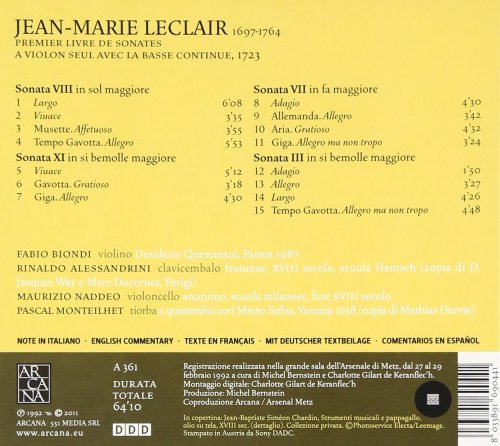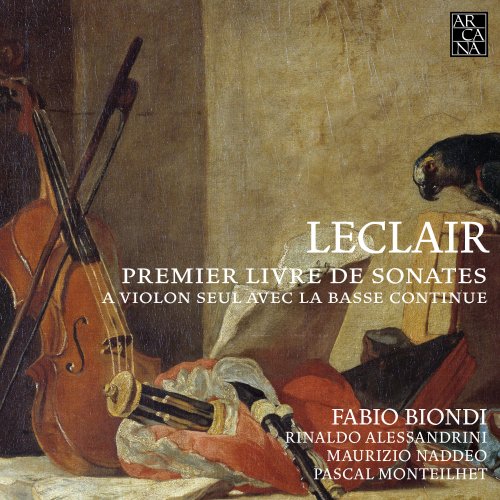
Rinaldo Alessandrini, Maurizio Naddeo, Pascal Monteilhet, Fabio Biondi - Leclair: Premier livre de sonates à violon seul avec la basse continue (1992)
BAND/ARTIST: Rinaldo Alessandrini, Maurizio Naddeo, Pascal Monteilhet, Fabio Biondi
- Title: Leclair: Premier livre de sonates à violon seul avec la basse continue
- Year Of Release: 1992
- Label: Arcana
- Genre: Classical
- Quality: flac lossless (tracks) +Booklet
- Total Time: 01:04:25
- Total Size: 356 mb
- WebSite: Album Preview
Tracklist
01. Sonate VIII in Sol Maggiore: I. Largo
02. Sonate VIII in Sol Maggiore: II. Viuace
03. Sonate VIII in Sol Maggiore: III. Musette. Affetuoso
04. Sonate VIII in Sol Maggiore: IV. Tempo Gavotta. Allegrp
05. Sonata XI in Si Bemolle Maggiore: I. Viuace
06. Sonata XI in Si Bemolle Maggiore: II. Gavotta. Gratioso
07. Sonata XI in Si Bemolle Maggiore: I. Giga. Allegro
08. Sonata VII in Fa Maggiore: I. Adagio
09. Sonata VII in Fa Maggiore: II. Allemanda. Allegro
10. Sonata VII in Fa Maggiore: III. Aria. Gratioso
11. Sonata VII in Fa Maggiore: IV. Giga. Allegro ma non tropo
12. Sonata III in Si Bemolle Maggiore: I. Adagio
13. Sonata III in Si Bemolle Maggiore: II. Allegro
14. Sonata III in Si Bemolle Maggiore: III. Largo
15. Sonata III in Si Bemolle Maggiore: IV. Tempo Gavotta. Allegro ma non tropo

When this album first appeared in 1992, violinist Fabio Biondi and keyboardist Rinaldo Alessandrini attracted little attention in comparision with the better-known historical-instrument specialists of northwestern Europe. Biondi's ensemble Europa Galante was still in its early years, and Alessandrini's hyper-dramatic Vivaldi readings were still years in the future. But the originality was there for those with ears to hear in these recordings of violin-and-continuo sonatas from Jean-Marie Leclair's first book, published in 1723. They don't really resemble Biondi's later recordings of Vivaldi's Four Seasons concertos and the like, but they were and have remained fresh readings of French repertory in which many performances have the whiff of rote. Biondi, playing not his trademark 1766 Gagliano instrument but a modern Baroque violin by Parmesan maker Desiderio Quercetani, forges a quintessentially French sound, with the bow strokes trailing off into affecting little caresses. Try one of the moderate-tempo dances, such as the gratioso-marked Gavotta of the Sonata No. 11 (track 6), for the full effect. These pieces, though designated sonatas by the composer, are uncommonly tight fusions of Italian sonatas and French dance suites, and Biondi throws himself into expressing this duality as an audience of the 18th century would have heard it. With excellent sound from the Metz Arsenal, an early success for recording early music digitally, this remains a prime pick for Leclair's winsome violin sonatas.
01. Sonate VIII in Sol Maggiore: I. Largo
02. Sonate VIII in Sol Maggiore: II. Viuace
03. Sonate VIII in Sol Maggiore: III. Musette. Affetuoso
04. Sonate VIII in Sol Maggiore: IV. Tempo Gavotta. Allegrp
05. Sonata XI in Si Bemolle Maggiore: I. Viuace
06. Sonata XI in Si Bemolle Maggiore: II. Gavotta. Gratioso
07. Sonata XI in Si Bemolle Maggiore: I. Giga. Allegro
08. Sonata VII in Fa Maggiore: I. Adagio
09. Sonata VII in Fa Maggiore: II. Allemanda. Allegro
10. Sonata VII in Fa Maggiore: III. Aria. Gratioso
11. Sonata VII in Fa Maggiore: IV. Giga. Allegro ma non tropo
12. Sonata III in Si Bemolle Maggiore: I. Adagio
13. Sonata III in Si Bemolle Maggiore: II. Allegro
14. Sonata III in Si Bemolle Maggiore: III. Largo
15. Sonata III in Si Bemolle Maggiore: IV. Tempo Gavotta. Allegro ma non tropo

When this album first appeared in 1992, violinist Fabio Biondi and keyboardist Rinaldo Alessandrini attracted little attention in comparision with the better-known historical-instrument specialists of northwestern Europe. Biondi's ensemble Europa Galante was still in its early years, and Alessandrini's hyper-dramatic Vivaldi readings were still years in the future. But the originality was there for those with ears to hear in these recordings of violin-and-continuo sonatas from Jean-Marie Leclair's first book, published in 1723. They don't really resemble Biondi's later recordings of Vivaldi's Four Seasons concertos and the like, but they were and have remained fresh readings of French repertory in which many performances have the whiff of rote. Biondi, playing not his trademark 1766 Gagliano instrument but a modern Baroque violin by Parmesan maker Desiderio Quercetani, forges a quintessentially French sound, with the bow strokes trailing off into affecting little caresses. Try one of the moderate-tempo dances, such as the gratioso-marked Gavotta of the Sonata No. 11 (track 6), for the full effect. These pieces, though designated sonatas by the composer, are uncommonly tight fusions of Italian sonatas and French dance suites, and Biondi throws himself into expressing this duality as an audience of the 18th century would have heard it. With excellent sound from the Metz Arsenal, an early success for recording early music digitally, this remains a prime pick for Leclair's winsome violin sonatas.
As a ISRA.CLOUD's PREMIUM member you will have the following benefits:
- Unlimited high speed downloads
- Download directly without waiting time
- Unlimited parallel downloads
- Support for download accelerators
- No advertising
- Resume broken downloads


